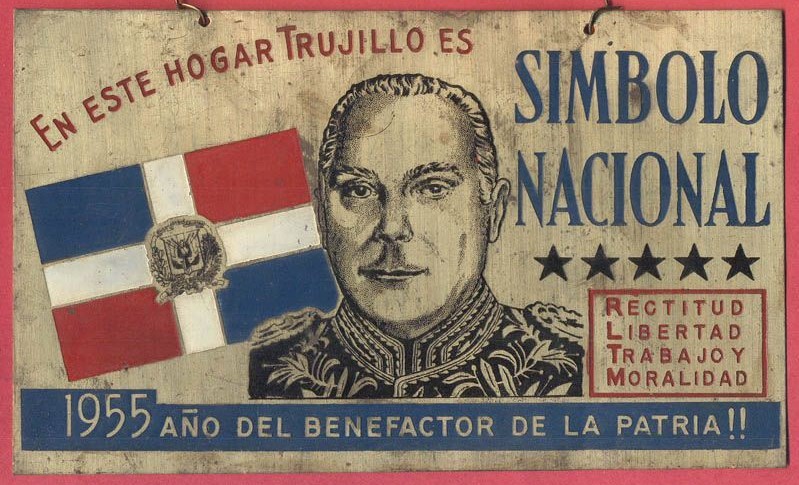The sources for this theme all pertain to the dictatorship of Rafael Trujillo, who reigned in the Dominican Republic from 1930 until his assassination in 1961.
Trujillo is a complicated historical figure. He initially came to power democratically, vowing to restore the nation’s sovereignty after US occupation in the 1910s and 1920s, and to transform the DR from a sugar-exporting backwater into a modern, prosperous, and respected country. As is so common around the globe, he declared that such urgent ambitions required a strong, virtuous, heroic, visionary man to push through reforms that may be painful at first, but would lead to greatness. In such vein, he built around himself a cult of personality — that is, a robust propaganda machine that propounded the idea that Trujillo alone was the only man who could guide the Dominican Republic to its God-given and glorious destiny.
But Trujillo also ruled with an iron fist, using the national police and the army to intimidate, jail, and murder his political enemies, censoring (and simply shutting down) the press, disbanding opposition political parties and labor unions, and creating a general atmosphere of fear amongst the population. The United States supported Trujillo (albeit with some reservations), because he violently suppressed socialist and communist political activism. This was in keeping with US policy across the hemisphere during the Cold War (1945-1991): the US supported dictators from Guatemala to Chile as they were seen as reliable allies against the spread of communism.

The placard reads: “In this home Trujillo is the symbol of the nation. Righteousness, Liberty, Work, and Morality. 1955: Year of the Benefactor of the Homeland!!”
Trujillo’s cult of personality and his designs for the nation were a mishmash of both traditional and modern ideas about race, gender, and national identity. For instance, Trujillo’s track record with women was full of contradictions. On the hand, Trujillo was famously a womanizer (and by today’s standards a rapist) and had very traditional ideas about the role of women’s behavior and morality. On the other hand, he exalted women as the symbols and mothers of the nation, he gave women the vote long before many other Latin American nations, and he strongly desired other countries to see the Dominican Republic as a modern, enlightened, progressive nation. By trying to understand such contradictions and complexity, we can understand better what Trujillo meant to the millions of Dominicans who supported his regime.
Trujillo understood the nation’s problems and their solutions in terms of racial stereotypes and proper and improper gender roles; and he fashioned himself as the “Savior of the Nation” by carefully manipulating contemporary Dominican cultural norms regarding race and gender. Through the readings and sources below, you’ll explore how and why this was so.
The big question:
How were ideas about gender (that is, about the proper positions and roles of women and men in Dominican society) crucial to Trujillo’s public persona and his self-proclaimed unique ability to solve the nation’s problems?
Sources
As with all of the themes, this one advances in four stages.
Stage 1
For Stage one you need to read both of these. The first provides some background, and the second is a primary historical source. Given the background information, what might this source show us about how Trujillo maintained power?
Stage 2
For stage 2, use this reading to further develop your ideas about the meaning of Nanita’s biography of Rafael Trujillo.
Stage 3
For this stage you have another secondary source written by a historian. Use this to reflect one more time on Nanita’s biography: In what ways was Trujillo’s cult of personality gendered?
Stage 4
Now apply the ideas you’ve developed above to another primary historical source: What does this speech show us about gender were mobilized by Trujillo’s regime to compel participation in its ambitions?